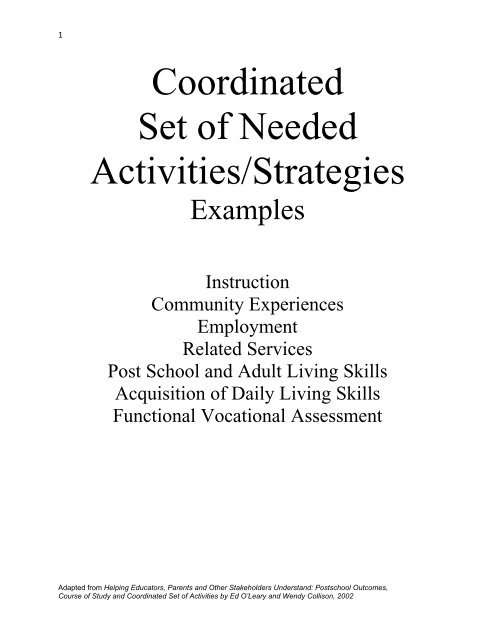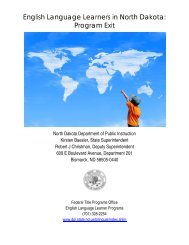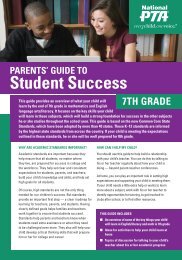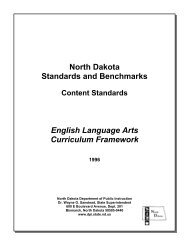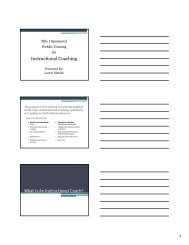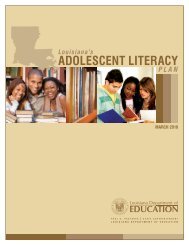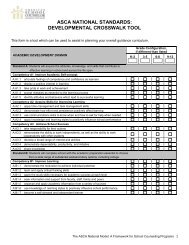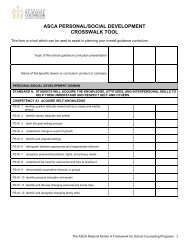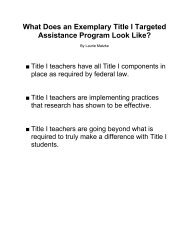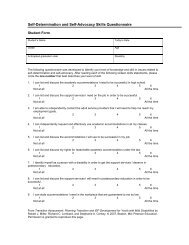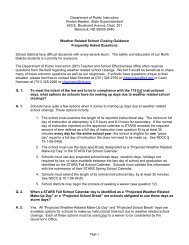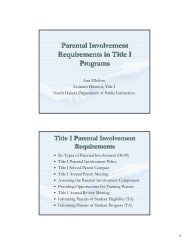Coordinated Set of Needed Activities/Strategies Examples
Coordinated Set of Needed Activities/Strategies Examples
Coordinated Set of Needed Activities/Strategies Examples
Create successful ePaper yourself
Turn your PDF publications into a flip-book with our unique Google optimized e-Paper software.
1<br />
<strong>Coordinated</strong><br />
<strong>Set</strong> <strong>of</strong> <strong>Needed</strong><br />
<strong>Activities</strong>/<strong>Strategies</strong><br />
<strong>Examples</strong><br />
Instruction<br />
Community Experiences<br />
Employment<br />
Related Services<br />
Post School and Adult Living Skills<br />
Acquisition <strong>of</strong> Daily Living Skills<br />
Functional Vocational Assessment<br />
Adapted from Helping Educators, Parents and Other Stakeholders Understand: Postschool Outcomes,<br />
Course <strong>of</strong> Study and <strong>Coordinated</strong> <strong>Set</strong> <strong>of</strong> <strong>Activities</strong> by Ed O’Leary and Wendy Collison, 2002
2<br />
Suggested Transition <strong>Activities</strong>/<strong>Strategies</strong> for<br />
“Instruction”<br />
<strong>Activities</strong>/strategies listed in this area have to do with “instruction,” whether that is a formal or<br />
informal imparting <strong>of</strong> knowledge or skills. The activities/strategies can include, but are not<br />
limited to, such things as:<br />
1. Complete a learning styles inventory to identify preferences and strength modes<br />
2. Collect information regarding the student’s desired postsecondary educational involvement<br />
3. Visit college campuses and meet with student support services<br />
4. Enrollment in a tech-prep program<br />
5. Learn about Section 504 <strong>of</strong> the Rehabilitation Act and Americans with Disabilities Act<br />
6. Explore admission requirements for possible part-time enrollment at a Vocational/Technical School<br />
7. Learn about the process for accessing apartments for rent<br />
8. Obtain information on continuing adult education opportunities<br />
9. Enroll in Self-Advocacy/Self-Awareness Studies<br />
10. Enroll in career and vocational education/vocational English<br />
11. Take occupation specific courses<br />
12. Enroll in an adult living course<br />
13. Enroll in an internship/apprenticeship program<br />
14. Participate in extra curricular activities such as __________<br />
15. Enroll in Adult/Continuing Education courses such as __________<br />
16. Enroll in Community College courses such as __________<br />
17. Enroll in parenting classes<br />
18. Learn financial management-money skills<br />
19. Learn about time management<br />
20. Practice negotiation skills for job raises, car purchases, etc.<br />
21. Access tutoring services in school or through a private agency<br />
22. Write an information interview letter to the disabilities resource coordinator at a postsecondary school<br />
<strong>of</strong> interest<br />
23. Take a GED pre-test<br />
24. Take a CPR/First Aid course<br />
25. Enroll in a SAT prep course<br />
26. College prep: courses, ACT/SAT, application<br />
27. Learn about community agencies that provide services and support to people with disabilities<br />
28. Tour post school occupational training programs<br />
29. Obtain, complete, and submit applications to colleges <strong>of</strong> choice<br />
30. Research college scholarship opportunities<br />
31. Obtain, complete, and submit applications for tuition assistance programs<br />
32. Enroll in and take classes through the local County Extension Program<br />
33. Special Education supports in identified classed<br />
34. Apply for and take ACT testing with accommodations.<br />
35. Take Transportation Mobility courses<br />
36. Learn and practice self-advocacy<br />
37. Develop work readiness skills and vocational English<br />
38. Learn about and practice social skills<br />
39. Learn about and practice communication skills<br />
40. Learn about the decision making process and practice the skills<br />
41. Develop Crisis Management skills<br />
42. Take driver’s education<br />
Adapted from Helping Educators, Parents and Other Stakeholders Understand: Postschool Outcomes,<br />
Course <strong>of</strong> Study and <strong>Coordinated</strong> <strong>Set</strong> <strong>of</strong> <strong>Activities</strong> by Ed O’Leary and Wendy Collison, 2002
3<br />
Suggested Transition <strong>Activities</strong>/<strong>Strategies</strong> for<br />
“Community Experiences”<br />
<strong>Activities</strong>/strategies listed in this area emphasize activities/strategies that are<br />
generally provided outside the school building and that prepare the student for<br />
participation in community life. These activities should encourage the student to<br />
participate in the community, including government, social, recreational, leisure,<br />
shopping, banking, transportation, or other opportunities.<br />
1. Learn how to access and/or use relevant community resources (health care facilities, bank, library, Laundromat,<br />
postal services, church, restaurant, hair stylist)<br />
2. Learn to make and keep own appointments<br />
3. Learn to identify appropriate resource for problem solving<br />
4. Skill training to demonstrate appropriate social behaviors in the community (tipping, asking for assistance,<br />
standing in line, being quiet in relevant situations)<br />
5. Skill training to demonstrates an understanding <strong>of</strong> cost saving techniques (comparison shopping, sale prices,<br />
discount stores versus department stores)<br />
6. Learn to get around in the community (driver’s license/vehicle, public transportation,<br />
maps/schedules/asking for directions)<br />
7. Develop a realistic plan for addressing post secondary housing needs and demonstrates the ability to<br />
secure housing (understands cost <strong>of</strong> different types <strong>of</strong> housing, housing contracts, process <strong>of</strong><br />
relocating)<br />
8. Apply for residential services<br />
9. Develop an understanding <strong>of</strong> basic insurance needs and where to purchase coverage<br />
10. Training to be able to locate specified areas with his/her own school and neighborhood<br />
11. Skill training to be able to understands relevant community signs (Men, Women, Do Not Enter, Danger)<br />
12. Skill training to select and order his/her own food in restaurants<br />
13. Skill training to safely cross streets including those with traffic lights<br />
14. Develop skills to access needed items in grocery store<br />
15. Skill training to recognize and understand cost and pay for small purchases in the community<br />
16. Skill training to understand purchasing options when paying for large purchases in the community (credit cards,<br />
loans)<br />
17. Training to understand and know the dangers <strong>of</strong> accepting assistance or goods from strangers<br />
18. Training to use a cell phone<br />
19. Develop the ability to respond to emergency situations in the community (missing the bus, contact with<br />
strangers, being lost)<br />
20. Develop the skills to identify the locations <strong>of</strong> and get to social service agencies (employment agencies,<br />
rehabilitation services, social services, adult services)<br />
21. Practice banking, budgeting, and shopping skill<br />
22. Use public transportation or get a driver’s license<br />
23. Join local organization or club<br />
24. Register to vote, learn how to vote<br />
25. Explore new ways to use leisure time<br />
26. Identify any supports needed to participate in activities<br />
27. Knowledgeable about banking options: checking, savings, etc.<br />
28. Identify specific community facilities to join for recreation/leisure services<br />
29. Identify specific recreation/leisure activities <strong>of</strong> choice and participate independently<br />
30. Identify activities <strong>of</strong> choice to do with family members or friends<br />
31. Identify activities <strong>of</strong> choice to do with a provider<br />
32. Investigate participation in church/temple or social/recreation events<br />
33. Learn about and visit potential places in the community to shop for food, clothes, etc.<br />
Adapted from Helping Educators, Parents and Other Stakeholders Understand: Postschool Outcomes,<br />
Course <strong>of</strong> Study and <strong>Coordinated</strong> <strong>Set</strong> <strong>of</strong> <strong>Activities</strong> by Ed O’Leary and Wendy Collison, 2002
4<br />
34. Investigate youth volunteer programs at the library<br />
35. Investigate youth volunteer programs at the hospital<br />
36. Investigate participation in community sports teams or organizations (s<strong>of</strong>tball, bowling, etc.)<br />
37. Join a community recreation center <strong>of</strong> YMCA<br />
38. Learn about the community theater group<br />
39. Learn about the community horticultural club<br />
40. Learn about the community historical preservation society<br />
41. Identify different living/housing options<br />
42. Tour apartments for rent<br />
43. Investigate participation in community civic and social organization (Lions Club, Jaycees, Kiwanis,<br />
etc.)<br />
44. Obtain a state identification card or driver’s license<br />
45. Join a community team or organization (church group, bowling league, etc.)<br />
46. Learn to ride a skateboard, roller blade, bike, or other outdoor activity<br />
47. Observe a courtroom or jury duty process<br />
48. Register for classes with city parks and adaptive recreation programs<br />
49. Register with Selective Service<br />
Suggested Transition <strong>Activities</strong>/<strong>Strategies</strong> for<br />
“Employment”<br />
<strong>Activities</strong>/strategies listed in this area focus on development <strong>of</strong> work-related<br />
behaviors, job seeking and keeping skills, career exploration, skill training,<br />
apprenticeship training, and actual employment.<br />
1. Collect information regarding the student’s desired employment and career interests for adult life<br />
2. beyond college and/or postsecondary vocational training<br />
3. Work towards obtaining a license to become a __________<br />
4. Meet with adult workers in the career field <strong>of</strong> __________<br />
5. Participate in a career awareness program<br />
6. Participate in a community-based career exploration program<br />
7. Explore possible summer employment through the Summer Youth JTPA program<br />
8. Meet with supported employment agencies to identify and evaluate their services<br />
9. Participate in a supported employment job experience<br />
10. Learn about employability skills and schedule a work experience<br />
11. Learn about the county one-stop career centers<br />
12. Obtain information and/or apply for youth apprenticeship program<br />
13. Complete the online application for Vocational Rehabilitation<br />
14. Schedule a visit with the local VR <strong>of</strong>fice to determine eligibility for services<br />
15. Meet with a VR counselor to develop an Individualized Plan for Employment (IPE)<br />
16. Write a Plan for Achieving Self-Support (PASS) and submit it to Social Security to obtain funding for<br />
starting a business<br />
17. Learn more about the voucher for Ticket to Work (for SSI beneficiaries) and interview providers<br />
18. Contact the state Commission for the Blind and Visually Impaired to obtain employment services<br />
19. Register with Employment Services<br />
20. Take the ASVAP<br />
21. Visit the labor organization <strong>of</strong>fices for a local union<br />
22. Practice completing job applications and interviewing skills<br />
23. Obtain a paid job in an area <strong>of</strong> interest<br />
24. Conduct an informational interview with military branch <strong>of</strong>ficers<br />
25. Memorize your Social Security number<br />
26. Attend transition fair or career fair at school and/or in the community<br />
Adapted from Helping Educators, Parents and Other Stakeholders Understand: Postschool Outcomes,<br />
Course <strong>of</strong> Study and <strong>Coordinated</strong> <strong>Set</strong> <strong>of</strong> <strong>Activities</strong> by Ed O’Leary and Wendy Collison, 2002
5<br />
27. Obtain a list <strong>of</strong> providers to VR who conduct person-centered planning, job development and<br />
placement, and job coaching<br />
28. Draft resume, cover letters, and thank you notes for after interviews<br />
29. Meet with a Job Corps counselor<br />
30. Participate in job shadowing<br />
31. Observe job site and develop a task analysis for job activities<br />
32. Purchase clothes for job interviews<br />
33. Meet with armed forces recruiter<br />
34. Practice punctuality<br />
35. Understand factors which influence job retention, dismissal, and promotion<br />
36. Respond appropriately to verbal correction from others<br />
37. Maintain a productive work rate<br />
38. Follow directions without complaint<br />
39. Maintain appropriate work habits when supervisor is not present<br />
40. Demonstrate the skills necessary to perform successfully in a job interview<br />
41. Accurately complete a job application<br />
42. Have a variety <strong>of</strong> successful community-based work experience<br />
43. Participate in chores at home<br />
44. Visit possible employment sites<br />
45. Volunteer in your community<br />
46. Learn how to interview, write resumes, cover letters, and do a job search<br />
47. Get a part-time job in your area <strong>of</strong> interest<br />
48. Go on informational interviews with employers<br />
49. Learn your strengths and skills<br />
50. Demonstrate good attendance<br />
51. Demonstrate appropriate hygiene and grooming<br />
52. Recognize the need to eventually support himself/herself<br />
53. Understand how work provides opportunity to develop personal relationships<br />
54. Understand how work contributes to self-confidence<br />
55. Understand how workers contribute to society<br />
56. Understand a paycheck<br />
57. Responds appropriately to authority figures<br />
58. Develop skills to understand that some jobs do not require further education<br />
59 . Develop an understanding <strong>of</strong> the relationship between specific jobs and the education required<br />
60. Learn to access various resources for assistance in job searching: want ads, employment agencies, online<br />
resources<br />
61. Skill training to develop the necessary interpersonal skills to work with others (good listening skills, good<br />
verbal communication skills)<br />
Suggested Transition <strong>Activities</strong>/<strong>Strategies</strong> for<br />
“Related Services”<br />
<strong>Activities</strong>/strategies in this area should consider the current and projected related<br />
service needs <strong>of</strong> the student. This area <strong>of</strong> the statement <strong>of</strong> needed transition services is<br />
not for specifying the needed related services for the next school year. Related<br />
services for the coming school year should be addressed in another section <strong>of</strong> the IEP.<br />
Rather, the context <strong>of</strong> related services in this statement has to do with determining if<br />
the related service needs will continue beyond school, helping to identify who or what<br />
agency might provide those services, helping to identify how the student and parent<br />
can access those services and then connecting the student and parent to whomever will<br />
provide those services before the student leaves the school system. This type <strong>of</strong><br />
Adapted from Helping Educators, Parents and Other Stakeholders Understand: Postschool Outcomes,<br />
Course <strong>of</strong> Study and <strong>Coordinated</strong> <strong>Set</strong> <strong>of</strong> <strong>Activities</strong> by Ed O’Leary and Wendy Collison, 2002
6<br />
planning, discussion, and identifying <strong>of</strong> activities/strategies should make the move<br />
from the school being one related service provider to another adult agency or service<br />
provider as seamless as possible for students and families.<br />
1. Rehabilitation counseling<br />
2. Orientation and mobility services<br />
3. Develop linkages to adult agencies or providers<br />
4. Develop a list <strong>of</strong> people, phone numbers, etc., who can be resources to you once you leave school. Keep<br />
this information in a safe place that you remember!!!<br />
5. Apply at adult support agencies<br />
6. Identify and visit community mental health agencies<br />
7. Identify potential post school providers <strong>of</strong> related services and funding sources<br />
8. Identify potential post school providers <strong>of</strong> recreation therapy or occupational therapy and potential<br />
funding sources<br />
9. Visit potential post school providers <strong>of</strong> physical therapy<br />
10. Apply for a mentor through a local, non-pr<strong>of</strong>it agency for counseling <strong>of</strong> substance abuse and<br />
delinquency<br />
11. Engage in conversations using an augmentative communication device<br />
12. Receive orientation and mobility training in place <strong>of</strong> employment<br />
13. Learn about potential post school providers <strong>of</strong> speech therapy<br />
14. Explore city/county transportation options<br />
15. Apply for eligibility with state transportation program<br />
16. Apply for eligibility with the state division <strong>of</strong> Mental Health Services<br />
17. Apply for Supplemental Security Income (SSI) from the Social Security Administration (SSA)<br />
18. Write a Plan for Achieving Self-Support (PASS) and submit it to SSA to obtain funding for<br />
transportation to and from a job<br />
19. Identify possible sources <strong>of</strong> support for coping with difficult life situations<br />
20. Obtain a driving capability assessment from __________<br />
21. Interview and select an adult provider<br />
22. Modify vehicle — explore options for modified transportation<br />
23. Complete an assistive technology evaluation<br />
24. Enroll in a delinquency prevention program<br />
25. Obtain new equipment (wheelchair, seating, braces, Assistive Technology, etc.)<br />
26. Line up audiological services for post school<br />
27. Contact college/tech school to arrange for class interpreters<br />
28. Include involvement <strong>of</strong> school health and social work services<br />
Suggested Transition <strong>Activities</strong>/<strong>Strategies</strong> for<br />
“Other Post School and Adult Living Objectives”<br />
<strong>Activities</strong>/strategies listed in this area emphasize activities/strategies that focus on<br />
adult living skills. These are generally those activities that are done occasionally such<br />
as registering to vote, filing taxes, obtaining a driver’s license, renting or buying a<br />
home, accessing medical services, obtaining and filing for insurance, planning for<br />
retirement, and accessing adult services such as Social Security.<br />
1. Collect information regarding the student’s desired residential life beyond high school and a residential<br />
postsecondary education setting<br />
2. Make application for post secondary housing<br />
3. Make applications to post secondary educational options<br />
Adapted from Helping Educators, Parents and Other Stakeholders Understand: Postschool Outcomes,<br />
Course <strong>of</strong> Study and <strong>Coordinated</strong> <strong>Set</strong> <strong>of</strong> <strong>Activities</strong> by Ed O’Leary and Wendy Collison, 2002
7<br />
4. Apply for financial assistance to access post secondary training/learning options<br />
5. Skill training for development <strong>of</strong> self confidence (i.e. communicates need for appropriate accommodations,<br />
practices self advocacy skills in a variety <strong>of</strong> settings, feels good about self)<br />
6. Skill training for self awareness (i.e. understanding <strong>of</strong> physical self; identifies abilities, interests, areas <strong>of</strong><br />
weakness; understands personal emotions; understands the implications <strong>of</strong> disability; understands and<br />
identifies personal goals)<br />
7. Register to vote and learn about the election process<br />
8. Register for selective service and learn about public service obligations/opportunities<br />
9. Obtain a driver’s license<br />
10. Obtain assistance to complete a tax return<br />
11. Explore insurance issues/needs<br />
12. Explore guardianship issues and estate planning<br />
13. Apply for disability card for reduced fees with public transportation<br />
14. Obtain assistance on management <strong>of</strong> financial resources and legal issues<br />
15. Learn about managing/maintaining/performing simple repairs on a home and obtaining<br />
modifications/accommodations<br />
16. Open a bank account and manage finances/budgets/bills<br />
17. Apply for credit cards and manage personal debt<br />
18. Apply for housing assistance (HUD)<br />
19. Apply for consumer education on home buying and informed decision-making<br />
20. Visit adult service providers in the community<br />
21. Learn about expectations for eating in restaurants<br />
22. Obtain information on managing personal health and fitness<br />
23. Meet with a social worker to discuss interpersonal skill development<br />
24. Plan for vacation/leisure activities<br />
25. Learn about consumer skills, rights, and responsibilities<br />
26. Join the local YMCA, YWCA, health club, or community recreation center<br />
Suggested Transition <strong>Activities</strong>/<strong>Strategies</strong> for<br />
“Acquisition <strong>of</strong> Daily Living Skills”<br />
Daily living skills are those activities that adults do most every day. These can include such<br />
things as preparing meals, budgeting, maintaining a residence, paying bills, raising a family,<br />
caring for clothing, and/or personal grooming.<br />
1. Visit community agencies that provide daily living skills training to adults<br />
2. Develop a contact list <strong>of</strong> agencies that provide residential supports in this county<br />
3. Meet with and interview adults with disabilities and their families who are receiving residential<br />
supports<br />
4. Register with the Department <strong>of</strong> Human Services<br />
5. Contact a DHS case manager to be placed on the residential service waiting list<br />
6. Visit/tour a variety <strong>of</strong> adult housing options with supports<br />
7. Develop a network <strong>of</strong> informal supports (friends, neighbors, etc.)<br />
8. Explore possible technology and adaptive assistance<br />
9. Develop emergency procedures for use at home<br />
10. Take courses in foods, family life, child development, and life management<br />
11. Understand directions for taking medications<br />
12. Select a primary care physician and dentist<br />
13. Schedule and keep medical appointments<br />
14. File taxes<br />
15. Take childcare classes<br />
16. Take a cooking class<br />
Adapted from Helping Educators, Parents and Other Stakeholders Understand: Postschool Outcomes,<br />
Course <strong>of</strong> Study and <strong>Coordinated</strong> <strong>Set</strong> <strong>of</strong> <strong>Activities</strong> by Ed O’Leary and Wendy Collison, 2002
8<br />
17. Develop skills to know where and how to find post school housing<br />
18. Sign up for utilities (gas, water, electric, telephone, cable, etc.)<br />
19. Learn to operate a washer and dryer<br />
20. Visit a local car dealer to determine whether to buy or lease a car<br />
21. Prepare an initial housing budget (down payment, furniture, bath towels, cleansers, utilities, etc.)<br />
22. Cost compare for household items (appliances, linens, etc.)<br />
23. Meet with a doctor to discuss birth control/family planning options<br />
24. Manage daily time schedule<br />
25. Open a checking/savings account<br />
26. Manage money and pay bills<br />
27. Meet with a family financial planner<br />
28. Listen to the weather forecast to plan daily/weekly outings<br />
29. Develop a personal fitness routine<br />
30. Obtain a bank ATM card<br />
31. Visit a bank to discuss a car or school loan<br />
32. Meet with a potential landlord<br />
33. Investigate local insurance companies for automobile and rental or homeowner’s insurance<br />
34. Maintain a home or residence interior and exterior<br />
35. Skill training to purchase food<br />
36. Skill training to prepare meals<br />
37. Skill training in purchasing clothing and learning how to care for clothes<br />
38. Skill training to learn about the physical and personal care <strong>of</strong> children<br />
39. Learn and practice decision making skills<br />
40. Learn time management skills<br />
41. Skill training to care for personal toileting needs<br />
43. Skill training to dress and undress self<br />
44. Skill training to communicate personal information (i.e. name, address, gender, telephone number)<br />
45. Skill training to prepare and serve foods which requires little or no cooking<br />
46. Skill training to demonstrates acceptable eating behaviors (i.e. uses utensils appropriately, chews with mouth<br />
shut, takes appropriate sized bites, uses napkin, practices good manners)<br />
47. Skill training to dress appropriately for specific situations (i.e. weather, special events, casual, seasonal)<br />
48. Skill training in maintaining a comfortable room temperature in the home (i.e. open and close windows, adjust<br />
a thermostat, open and close doors)<br />
49. Skill training to chose and wear clothing appropriate in size, color, patter, and style<br />
51. Skill training to demonstrate safety precautions in the home (i.e. use <strong>of</strong> locks, proper use <strong>of</strong> appliances)<br />
52. Skill training to recognize when clothing repair is necessary and when to either mend the item or arrange for<br />
assistance<br />
53. Skill training to develop an understanding <strong>of</strong> words found in the home environment (i.e. on appliances, on<br />
medicines, on recipes)<br />
54. Skill training to act responsibly in caring for own and others’ property<br />
55. Skill training to prepare and serve simple foods which require cooking<br />
56. Skill training to develop a neat appearance (i.e. hair style, proper use <strong>of</strong> make-up, appropriate shaving, clean<br />
clothing)<br />
57. Skill training to maintain a clean body (i.e. bathe, use deodorant, brush teeth, care for menstrual needs,<br />
wash/dry hair)<br />
58. Skill training to determine temperature by reading a thermometer<br />
59. Learn to prepare and serve at least 3 simple meals which require little or no cooking<br />
61. Training to demonstrate proper judgment in food storage<br />
62. Skill training to learn how and when to seek medical assistance<br />
63. Skill training on how to treat minor illnesses (i.e. headaches, nausea, fever, body aches)<br />
64. Develop skills to perform light household maintenance (i.e. simple repairs, change light bulbs, unclog drain)<br />
66. Demonstrate qualities <strong>of</strong> a good citizen (i.e. obeys rules and laws, shows consideration for others,<br />
respects the environment)<br />
Adapted from Helping Educators, Parents and Other Stakeholders Understand: Postschool Outcomes,<br />
Course <strong>of</strong> Study and <strong>Coordinated</strong> <strong>Set</strong> <strong>of</strong> <strong>Activities</strong> by Ed O’Leary and Wendy Collison, 2002
9<br />
67. Develop a shopping list based on recognized household and personal needs<br />
68. Skill training to develop an acceptable understanding <strong>of</strong> concepts related to sexual awareness<br />
69. Skill training to sort, wash, dry, fold, and put away laundry<br />
70. Skill training to performs basic first aid skills (i.e. treating cuts and burns, performing the Heimlich maneuver)<br />
71. Skill training on measurement as it applies to everyday living<br />
72. Develop advanced telephone skills (i.e. long distance, phone card, directory, directory assistance,<br />
taking messages, call waiting/forwarding, cell phone)<br />
Suggested Transition <strong>Activities</strong>/<strong>Strategies</strong> for<br />
“Functional Vocational Assessment”<br />
A functional vocational evaluation is an assessment process that provides information<br />
about job or career interests, aptitudes, and skills. Information is gathered through situational<br />
assessments in the setting where the job is performed. This can include observations, formal<br />
or informal measures, and should be practical. Information gathered through a functional<br />
vocational assessment can be used to refine educational experiences, courses <strong>of</strong> study, and<br />
employment activities/strategies in the statement <strong>of</strong> needed transition services.<br />
1. Complete a functional vocational evaluation<br />
2. Produce observable work samples<br />
3. Complete an interest/aptitude survey<br />
4. Complete ASVAB<br />
5. Teacher and parents/guardians complete an Enderle-Severson Transition Rating Scale<br />
6. Complete a non-verbal picture career interest inventory<br />
7. Complete an application to VR<br />
8. Other ______________________________________________________________________<br />
Adapted from Helping Educators, Parents and Other Stakeholders Understand: Postschool Outcomes,<br />
Course <strong>of</strong> Study and <strong>Coordinated</strong> <strong>Set</strong> <strong>of</strong> <strong>Activities</strong> by Ed O’Leary and Wendy Collison, 2002


